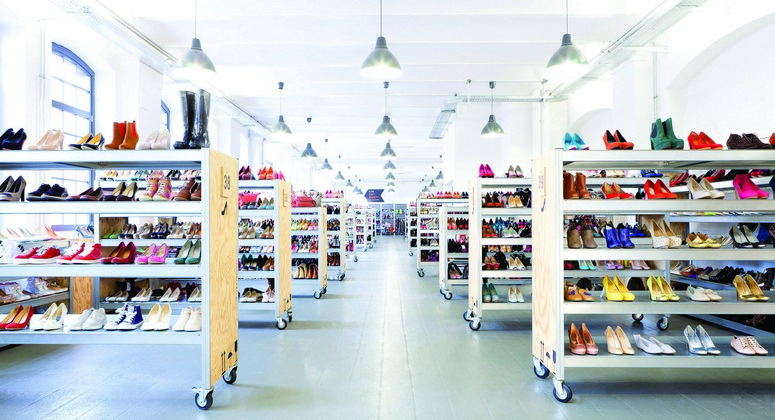ACROSS: What makes online retailers want to open up a bricks-and-mortar business?
KAI HUDETZ: The possibility of boosting sales and profits is definitely not always the driver. Retailers’ motivations can be compared with those of manufacturers. The ultimate aim is to position oneself as a brand—to become tangible and visible.
This in turn increases the advertising impact of other channels. In addition, good cross-channel opportunities, such as click & collect, arise thanks to stationary shops.
The bottom line is that there are quite different motives, which can also be seen from the concepts. The range extends from classic showrooms to concepts clearly aimed at sales, like that of MyMüsli.

Image: Zalando
ACROSS: What trends do you observe with online retailers entering the world of bricks-and-mortar retail?
HUDETZ: The overall trend is that more and more online businesses are taking this path. They have long recognized that it makes sense to tackle this topic and, if their business models allow it, to put it into practice.
The time when the original online retailers could behave according the motto “e-commerce wins!” are over. This is true despite the fact that the online market continues to grow even as the stationary market stagnates or even declines slightly. It’s important to note that the online players are taking their bricks-and-mortar ambitions extremely seriously. This can be compared to the movement of bricks-and-mortar retailers into the online world.
At the time, many retailers thought this would be a short “trip,” but dared to make the attempt anyway. As it turns out, the approach makes sense. In a final step, the task now is consistently implementing the strategy in terms of improving customer service.
ACROSS: How do online businesses get their clients to visit their stationary stores?
HUDETZ: In my experience, this usually does not require much additional motivation. The reason is that the shops are often located in high-frequency locations. Brands that are known online are thus instantly recognized in the stationary world—and people visit the shops. The idea is that the stores can stand on their own two feet straightaway due to the high frequency locations.
After all, we’re talking about strong brands with good images. The situation is different for companies like Zalando, which operate different concepts at different locations, like one for leftover stocks, for example.
ACROSS: You’ve already mentioned a few companies. Can you give examples of other online retailers that have successfully set up shop offline?
HUDETZ: It’s too early for a final assessment in most cases. A prime example, in my opinion, is the furniture brand “Fashion for Home.” Selling furniture exclusively online is known to be incredibly difficult. Given the size of the investment, customers want previously to have touched the wood of the sideboard or to have tried lying on the sofa bed before buying.
The amount of effort required for a return is also too great. Just think of a living environment that you turned out not to like. “Fashion for Home” makes successful use of their bricks-and-mortar showroom for this. Speaking of returned items: These are problematic in principle even if they are free.
Customers might have to, for example, tidily re-pack three pairs of shoes and bring them to the post office. Many would rather turn the shoes in at a stationary Deichmann store and let them handle it. It works.

Image: MyMuesli
ACROSS: How important are shopping centers for online merchants opening their first bricks-and-mortar business?
HUDETZ: Shopping centers are extremely important. After all, the onliners are mainly interested in qualified traffic because they lack most of the ways to draw traffic to ancillary sites themselves. Online traders have to select a high-frequency location. That high frequency must of course also include the target audience. Looking back on the last decades, it is clear that shopping malls are a must. Every online retailer dreams of a high-traffic mall.
ACROSS: Are factory outlet centers also possibilities as locations for them?
HUDETZZ: Yes, although that depends on the retailers’ motivations. Zalando’s first bricks-and-mortar store, for example, was clearly designed for a factory outlet. For MyMüsli or the eyeglass retailer Mister Spex, on the other hand, other issues were more important in the heavily frequented locations mentioned above.
Onliners are generally very data-driven. They examine numbers very closely prior to making decisions. They’re therefore familiar with the prognosis that states that the gap between high-frequency and low-frequency locations is widening.
The result is that top locations are getting more expensive, while the secondary locations are getting cheaper. Against this background, online retailers seeking high-frequency locations need to take rapid action.
ACROSS: You are a jury member for “First Store by Alexa.” What impetus do you expect from the competition?
HUDETZ: Retail needs more innovative energy and joy. “First Store by Alexa” provides a solid basis for both. In principle, nothing persuades a retailer like another retailer who can demonstrate a successful model.
A competition like this illustrates that the challenges are rising for all concerned because onliners are pushing with great momentum into the stationary market. This in turn pushes the long-established bricks-and-mortar retailers to try more on their spaces—keyword: digitization.
I believe and hope that “First Store by Alexa” will generate radiant models that show other retailers how it can work.

About “First Store by Alexa”
Alexa in Berlin is celebrating its tenth anniversary in September 2017. That’s reason enough for Union Investment, Sonae Sierra, and 21media to launch “First Store by Alexa,” a retail casting competition.
Four words are enough to stir up interest: six months’ base rent free. This is the prize that awaits the winners of the retail competition “First Store by Alexa” in the two categories “Best Brand” and “Best Newcomer.” The two stores will naturally open in Alexa—with 16 million customers annually one of the most successful malls in Europe.
Participation is possible until November 30, 2016.
More information: www.firststorealexa.com





